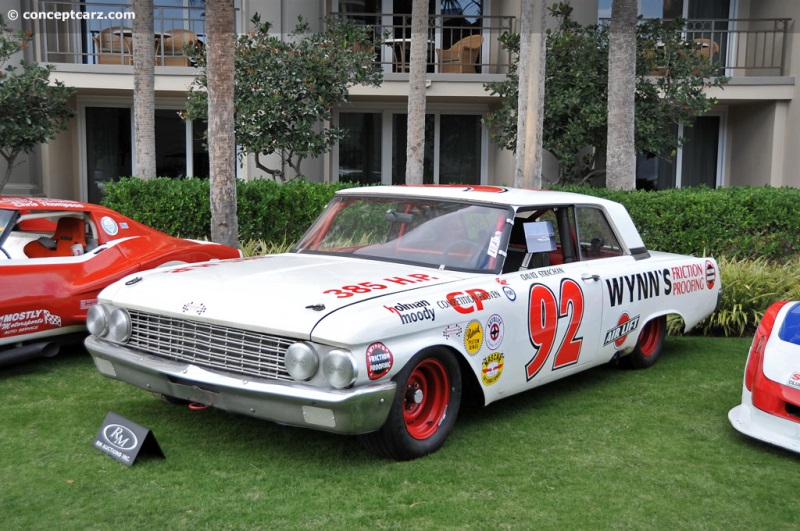Ford's legacy of performance was established during the flathead decades, but its first overhead-valve engines of the 1950s failed to inspire much enthusiasm. Robert McNamara, a Harvard-educated 'technocrat,' had joined Ford in 1946 as one of Colonel Charles 'Tex' Thornton's 'Whiz Kids.' By 1961, McNamara had been named company president, but his passionless approach to the car business had manifested in a lackluster lineup. Additionally, by late 1957, the Automobile Manufacturer's Association had announced a voluntary ban on using performance and speed as selling factors for their automobiles. Ford had several projects in the works when the ban went into effect and in 1958, the FE block which displaced 352 cubic inches and was rated at 300bhp, was introduced. In 1960, Ford brought out a high-performance edition of that engine, one fitted with an aluminum intake manifold, cast-iron headers, special brakes, wheels, and other internal tweaks with an output of 360 horses. In December of 1960, Chevrolet announced a 409 big-block V8, and although slow to ramp up production, its solid lifters and high-lift cam made it a formidable adversary. After McNamara left to become Secretary of Defense, his replacement - John Dykstra - worked quickly to re-establish a performance image at Ford. To that end, Ford engineers enlarged the 352 CI FE engine out to 390 CI and opened up its breathing to create a 300 HP base version, a 330 HP police unit, and the 375 HP Thunderbird Super edition. A dealer-installed triple two-barrel carburetor set-up was available which bumped the output to 401bhp.Impressive, but the company's success in both NASCAR and NHRA Super Stock competition began to falter, as 421-cubic inch Pontiacs and 413 Mopars took home more and more trophies. The slow roll-out of Chevy's 409, however, allowed Ford time to regroup. What resulted was more than just a bored-out 390. The new 406-cubic inch big block was recast, with thicker cylinder walls, stronger pistons and connecting rods, heads with larger valves, and adjustable ratio rocker arms. Cast iron headers fed a 2.5-inch dual exhaust system.As the next-generation engine, the 427, was being readied for production, work was underway on the '335' project the next generation V8. The name was not in reference to its size, rather its project number, and this would be Ford's last big-block engine design. With a displacement of 483ci, its horsepower estimated to be well north of 500. Never released as a production engine, a few of these experimental power plants evidently made into the public's hands.In the styling department, by the late 1950s, the American automotive scheme had fully embraced the rocket-age fantasies and the newspapers were full of the latest moves in the space race as Uncle Sam battled with the Soviet Union for supremacy in interplanetary exploration. No surprise then that when Ford launched its new top-of-the-range model in 1959, it was called the Galaxie. Although its name sparked thoughts of interstellar travel, its design abandoned the ostentatious fins and flourishes of the early 1950s for a more sober, sleek, and scientific look. Available as either a sedan or a convertible in two-door and four-door form, it came with a range of engines from a 3.7-liter straight-six to a gigantic 7-liter V8.
2-Door V8 Sedan
Chassis #: AQE-62-08
View info and history
Auction entries : 1By the early 1960s, the Ford Galaxie 500 was well-established as the fleet leader of 'The Lively Ones from Ford,' the most appealing of which was the Sunliner convertible introduced at mid-year. Styling of the 1962 Galaxie was even cleaner than the previous year's design, with mild Thunderbird influences in the front and rear contours. The previous concave front grille was replaced by a flat unit with horizontal bars, the vestigial fins were dropped, and the dramatic 'afterburner' tail lights were moved down into the bumper for a more integrated look. The 1961's very successful interior design was carried over virtually unchanged with the exception of engine-turned dash inserts. In 1962, the Galaxie name was applied to all of Ford's full-size models, as the Fairlane name was moved to a new intermediate model, and Custom was temporarily retired. New top-line Galaxie 500 (two-door sedan and hardtop, four-door sedan and hardtop, and 'Sunliner' convertible) models offered plusher interiors, more chrome trim outside and a few additional luxury items over and above what was standard on the plainer Galaxie models. The Sunliner name was used for the top models in Ford's full-size range from 1958 until 1961, in a marketing attempt to appeal to the excitement surrounding the Space Race. A Mileage Maker six-cylinder engine was standard, but few were sold without at least a 292/170 HP V-8, and buyers now had the option of choosing one of Ford's brand-new FE-block V-8 engines. Optional V-8 engines ranged from a 292 CI to the FE-series 390, including High Performance and Super High-Performance versions. Mid-year 1962, Ford introduced the 406 CID V8, the result of a .08-inch bore increase for the 390 and offered as a single four-barrel or six-barrel. At low speeds, the Tri-Power setup operated on the 330 CFM center carburetor. At wide-open throttle, the progressive linkage opened the pair of outboard 2-barrels rated at 350 CFM each for a total of 1,030 CFM. 
2-Door V8 Sedan
View info and historyThe B-Code came with the Thunderbird 406, with an 11.5:1 compression ratio, aluminum dual-plane intake manifold, and single Holley 600 four-barrel carburetor. It produced 385 brake horsepower at 5,800 rpm and 444 foot-pounds of torque. The G-Code came equipped with the Thunderbird 406 CID Super High-Performance V8 engine under the hood, offered strictly as a homologation special for NHRA Super Stock drag racing. It was offered in two versions with the top of the line setup being the Super Higher-Performance with 11.4:1 compression, triple Holley 2-barrel carburetors, gold valve covers, an aluminum intake, an oval air cleaner, and factory headers leading to dual exhaust. Ford rated the Super High-Performance 406 at 405 hp and 448 lb-ft of torque (seriously close to the 'magic formula' of one horsepower per cubic inch). The Tri-Power 406 was aimed squarely at serious drivers. Heavy Duty components included the suspension, brakes, differential, and driveshaft, along with 15-inch wheels and the Borg-Warner Toploader 4-speed manual was a mandatory option ($188) because even the Cruise-O-Matic couldn't handle the torque. The Borg-Warner T-10 was new for 1962, the first proper floor shifter available for the Galaxie 500. Externally, the muscle look is enhanced by the rakish stance, gold 406 fender emblems, and painted steel wheels with dog-dish Ford corporate hubcaps. Available in any Galaxie model except station wagons, the G-Code 406 impressed the staffers at Motor Trend, who touted 'something like Ferrari performance at a fifth of the price.' The 406 CID production was brief, offered for just two years.The G-Code 406 added a 25-percent increase over the base $2,674 MSPR, although some of that expenditure could be seen as savings on the features that Ford simply would not allow you to order with the Super High-Performance engine option: no Air Conditioning, no deluxe wheel covers, no power steering, no power brakes, no chrome engine bay dress-up kit, no automatic transmission of any variety.
2-Door V8 Sedan
View info and historyPart of Ford's Total Performance image was the Ford Galaxie drag-racing program, and for 1962, the factory-built just a handful of special lightweights. Company subcontractor Dearborn Steel Tubing reconstructed 11 specially built Galaxies strictly for racing, but when the 1963 model was released, a majority of these cars were subsequently updated to that body (four remain in 1962 configuration - two with original bodies). They wore fiberglass fenders, hoods, and decklids along with aluminum front bumpers, radiators, and inner fenders. The battery was relocated and the radio, heater, and body-filler were deleted. The stock bench was replaced by lighter bucket-style seats. A total of 164 pounds disappeared due to the replacement body panels and deleted item, resulting in a Galaxie that weighed under 3,400 pounds. Under the hood was a reworked 406 CI engine topped with two 4-barrel Holley carbs (a first for an FE application), special aluminum intake, and cast factory headers.The 'base' Galaxie was offered as a two- or four-door sedan with prices of $2,450 and $2,500, respectively. The combined production of the 'base' Galaxie was 170,524 units with 115,594 of those being the four-door and 54,930 being two-doors. The top-of-the-line trim was the Galaxie 500, available as a town sedan with a factory base price of $2,660, a club sedan at $2,615, a Town Vitoria at $2,740, and a club victoria at $2,675. The most popular was the town sedan with 174,195 examples built, followed by 87,562 of the club victoria, 42,646 of the Sunliner Convertible, 30,778 of the Town Victoria, and 27,824 of the Club Sedan. The Galaxie 500 added additional brightwork, trim, and accouterments, including chrome window moldings, chrome 'A' pillar moldings, chrome rocker panel moldings, quarter panel moldings, a chrome trim strip with a Ford crest at the bottom of the 'S' pillar, and a color-keyed horizontal chrome strip along the beltline. 
2-Door V8 Sedan
View info and historyThe Galaxie 500XL series was new for the 1962 model year and came with the features found on the Galaxie 500 plus bucket seats, an engine-turned insert in the instrument panel and on the side stripe, and a floor-mounted shift lever. The Club Victoria body style was priced at $3,100 and the Sunliner Convertible listed for $3,360. 28,412 examples of the club victoria were built along with 13,183 of the Sunliner Convertible. The combined Galaxie production for 1962, not including station wagons, was 575,124 units. The equipment installed in station wagons was identical to the Galaxie, with the Ranch Wagon similar equipped to the 'base' Galaxie, the Country Sedans similar to the Galaxie 500, and the Country Squires similar to the Galaxie 500XL. Ford built 129,651 examples of these wagons in 1962, with 33,674 being the Ranch Wagon, 47,63 units of the six-passenger Country Sedan, 16,562 of the nine-passenger Country Sedan, and 15,666 of the Country Squire. The standard six-cylinder engine had a 223 cubic-inch displacement, overhead valves, 8.4:1 compression, four main bearings, a Holley one-barrel carburetor, and delivered 138 horsepower at 4,200 RPM. The 292 CID V8 had a cast-iron block, overhead valves, five main bearings, a Holley two-barrel carburetor and delivered 170 horsepower at 4,200 RPM. The 390 CID V8 also had overhead valves, a cast-iron block, and five main bearings. 
2-Door V8 Sedan
View info and historyThe Galaxie rested on a 119-inch wheelbase platform and had an overall length of 109.3 inches. Ford station wagons rode on 8.00 x 14 tires and the Galaxie models rested on 7.50 x 14 tires. The combined 575,124 examples of the 1962 Ford Galaxie models built accounted for nearly forty-percent of Ford's total production.
by Daniel Vaughan | Mar 2021
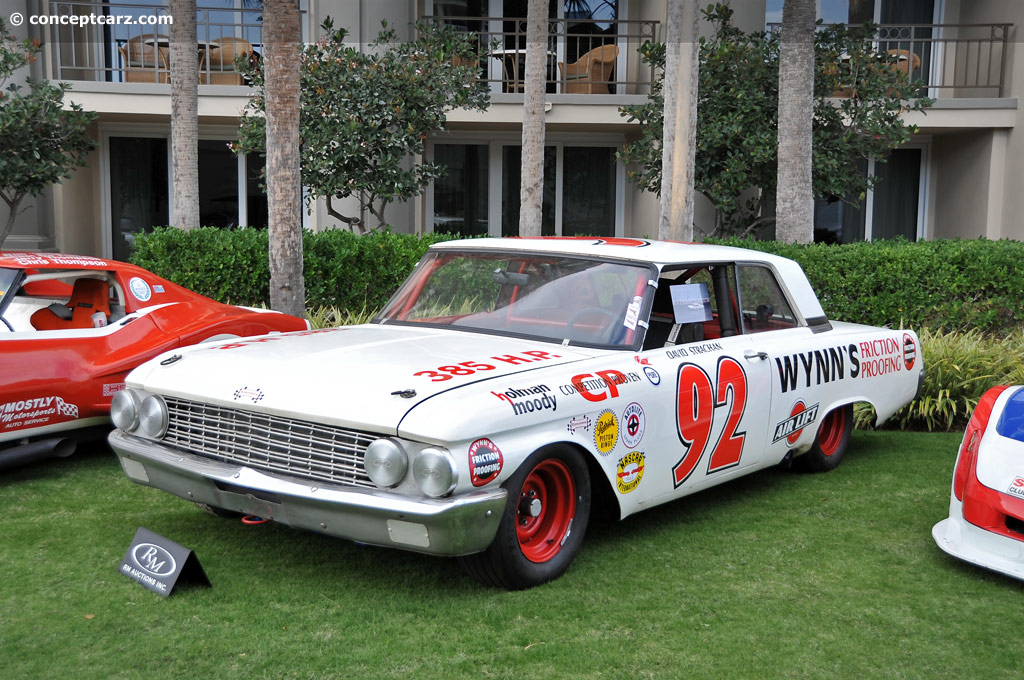
2-Door V8 Sedan
Chassis #: AQE-62-08
View info and history
Auction entries : 1
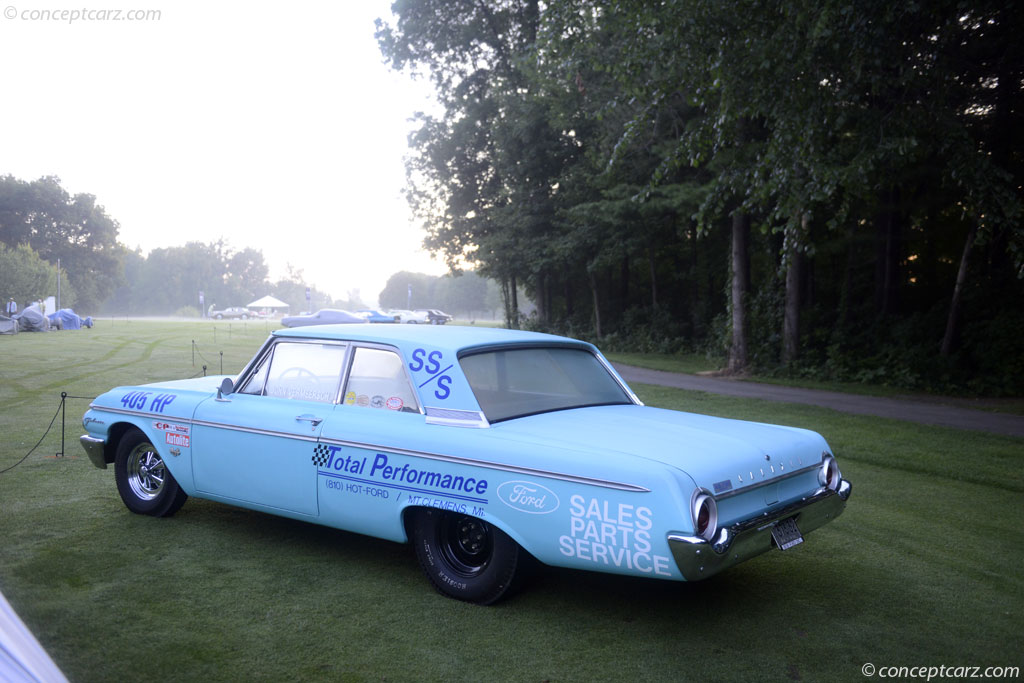
2-Door V8 Sedan
View info and history
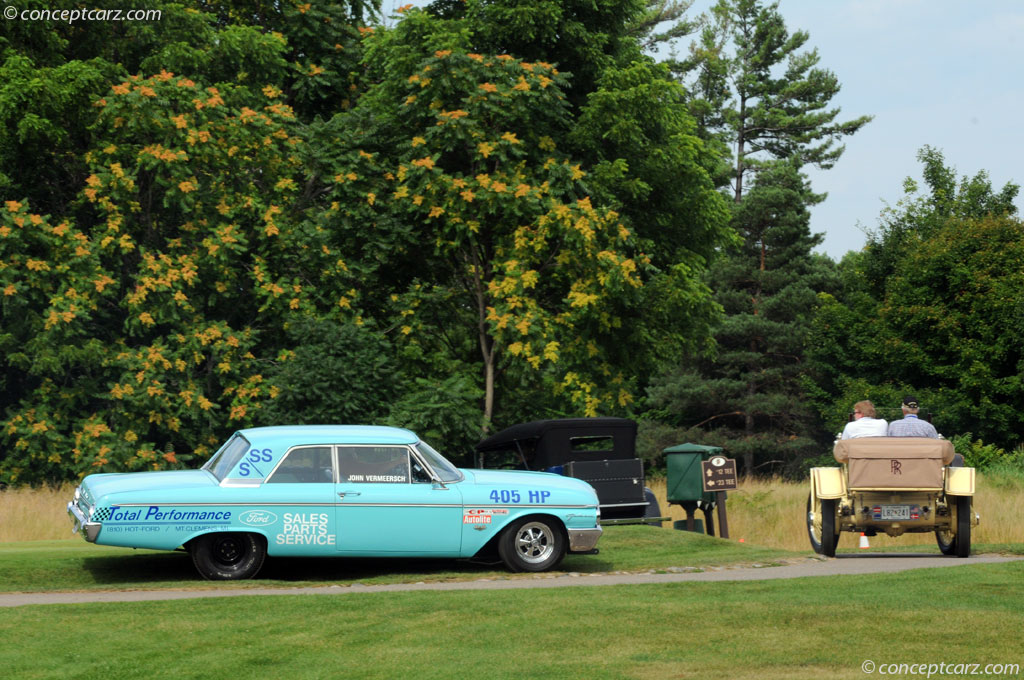
2-Door V8 Sedan
View info and history
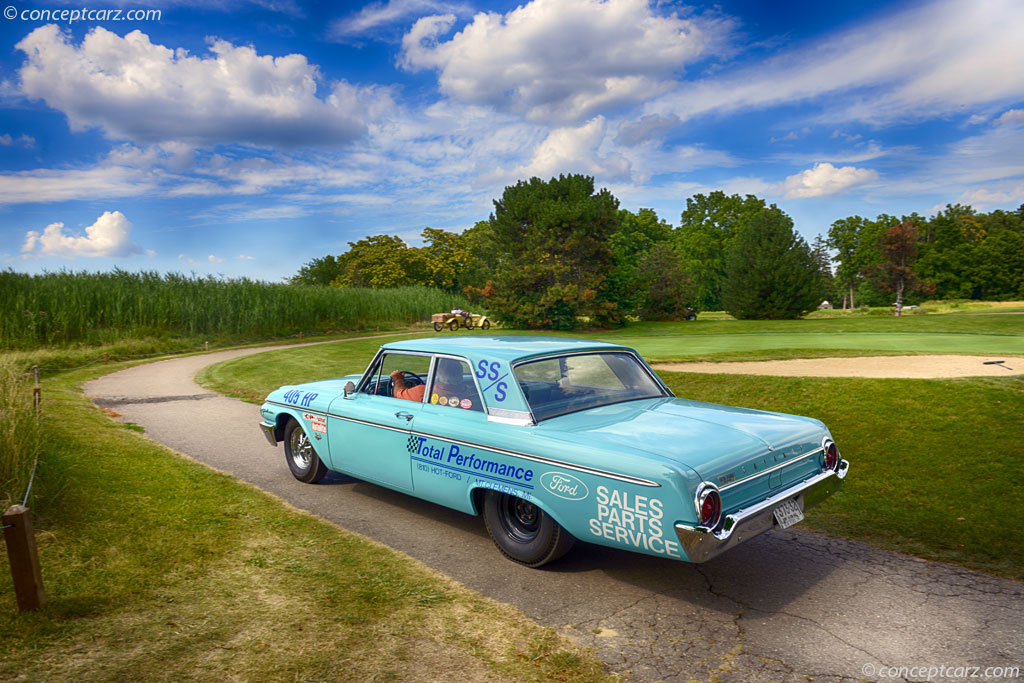
2-Door V8 Sedan
View info and history
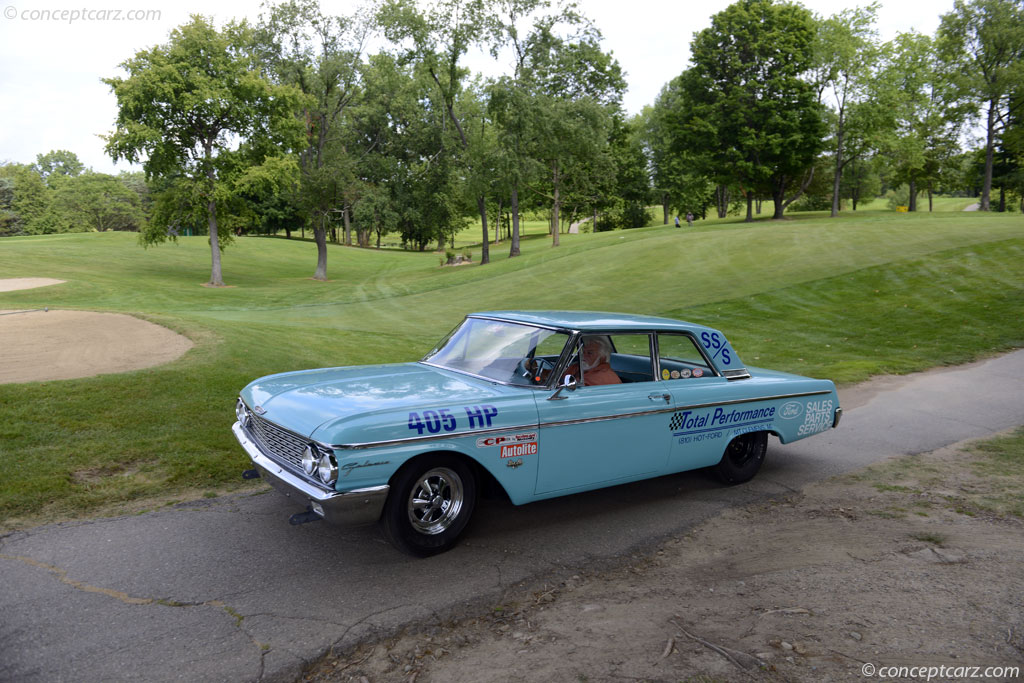
2-Door V8 Sedan
View info and history
by Daniel Vaughan | Mar 2021
Related Reading : Ford Galaxie History
The Ford Galaxie entered the scene in 1959 and was offered in various configurations. The model line consisted of a Club Victoria, Town Victoria, Club Sedan, Town Sedan, Sunliner Convertible, and Skyliner Retractable. Similar to the Fairlane, they were distinguished by different ornamentation. The highlight of the 1959 model line was the Skyliner Retractable that had an all-steel hardtop that....
Continue Reading >>
Continue Reading >>
Similarly Sized Vehicles
from 1962
Similarly Priced Vehicles
1962 Ford Galaxie Vehicle Profiles
Recent Vehicle Additions
Performance and Specification Comparison
Price Comparison
$1,990 - $2,600
$2,155 - $2,505
$3,020 - $3,200
$4,320 - $5,440
Galaxie Specification Comparison by Year
Year
Production
Wheelbase
Engine
Prices
289,268
119.00 in.
6 cyl., 223.00 CID., 145.00hp
8 cyl., 292.00 CID., 185.00hp
8 cyl., 292.00 CID., 185.00hp
$2,550 - $2,970
349,645
119.00 in.
6 cyl., 223.00 CID., 135.00hp
8 cyl., 292.00 CID., 175.00hp
8 cyl., 352.00 CID., 220.00hp
8 cyl., 390.00 CID., 300.00hp
8 cyl., 292.00 CID., 175.00hp
8 cyl., 352.00 CID., 220.00hp
8 cyl., 390.00 CID., 300.00hp
$2,540 - $2,965
575,124
119.00 in.
6 cyl., 223.00 CID., 138.00hp
8 cyl., 221.00 CID., 145.00hp
8 cyl., 292.00 CID., 170.00hp
8 cyl., 352.00 CID., 220.00hp
8 cyl., 390.00 CID., 300.00hp
8 cyl., 390.00 CID., 340.00hp
8 cyl., 406.00 CID., 385.00hp
8 cyl., 406.00 CID., 405.00hp
8 cyl., 221.00 CID., 145.00hp
8 cyl., 292.00 CID., 170.00hp
8 cyl., 352.00 CID., 220.00hp
8 cyl., 390.00 CID., 300.00hp
8 cyl., 390.00 CID., 340.00hp
8 cyl., 406.00 CID., 385.00hp
8 cyl., 406.00 CID., 405.00hp
$2,450 - $3,356
535,256
119.00 in.
6 cyl., 200.00 CID., 116.00hp
6 cyl., 223.00 CID., 138.00hp
8 cyl., 289.00 CID., 271.00hp
8 cyl., 390.00 CID., 300.00hp
8 cyl., 390.00 CID., 330.00hp
6 cyl., 223.00 CID., 138.00hp
8 cyl., 289.00 CID., 271.00hp
8 cyl., 390.00 CID., 300.00hp
8 cyl., 390.00 CID., 330.00hp
$2,610 - $3,625
591,531
119.00 in.
6 cyl., 223.00 CID., 138.00hp
8 cyl., 289.00 CID., 195.00hp
8 cyl., 289.00 CID., 225.00hp
8 cyl., 352.00 CID., 250.00hp
8 cyl., 289.00 CID., 271.00hp
8 cyl., 390.00 CID., 300.00hp
8 cyl., 390.00 CID., 330.00hp
8 cyl., 427.00 CID., 425.00hp
8 cyl., 289.00 CID., 195.00hp
8 cyl., 289.00 CID., 225.00hp
8 cyl., 352.00 CID., 250.00hp
8 cyl., 289.00 CID., 271.00hp
8 cyl., 390.00 CID., 300.00hp
8 cyl., 390.00 CID., 330.00hp
8 cyl., 427.00 CID., 425.00hp
$2,611 - $3,485
Related Automotive News

Barrett-Jackson to Offer a Spectacular Selection of Shelby Vehicles at the 2022 Scottsdale Auction, including a 1967 Shelby Cobra 427, the Lance Reventlow Cobra and a Premier Award-Winning 1965 GT350
Barrett-Jackson will celebrate 50 years of The Worlds Greatest Collector Car Auctions at its 2022 Scottsdale Auction, January 22-30, at WestWorld of Scottsdale. One of the most spectacular No Reserve dockets ever amassed at Barrett-Jackson, including...

Toyota NASCAR, Powri Victories And Championship Highlight Weekend
Toyota drivers compiled five wins in NASCAR and POWRi competition, as well as a championship in the NASCAR K%26N Pro Series East in racing action over the weekend.
NASCAR
Kyle Busch won Sundays Monster Energy NASCAR Cup Series Playoff...

CJ Greaves Captures TORC Title, NASCAR Drivers Advance In Playoffs
Tundra driver CJ Greaves captured his third TORC The Off-Road Championship Pro 4 title on Sunday, while Kyle Busch and Christopher Bell won in their respective NASCAR series to advance to the second round of the Playoffs.
NASCAR
Two Toyota...
MOPAR TO CELEBRATE 50TH ANNIVERSARY OF THE ICONIC 426 HEMI IN 2014
Mopar Unveils Logo, Special Product Line and Plans Marketing Events
2014 marks 50th anniversary of the introduction of the Gen II 426 Race HEMI®
Mopar unveils 50th anniversary HEMI logo celebrating the iconic engine
Engine made its legendar...

Barrett-Jackson Flavors Its January Scottsdale Auction With NASCAR Treats
RACING HERITAGE, HIGH PERFORMANCE ARE RECIPES FOR CAR-COLLECTING FEAST
SPEED™ SET FOR 39 HOURS of LIVE COVERAGE STARTING JAN. 15
The great Henry Ford once said, Auto racing began five minutes after the second car was built.
...


























